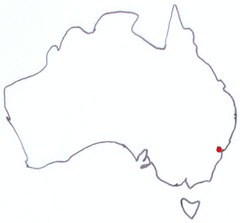
Een tijdje terug hoorden we al over de overproductie in Australie.
Een deel van de druiven wordt niet geplukt omdat er nog te veel wijn van vorig jaar is, en de overheid gaat de wijnboeren meer subsidie geven.
Harvey Steiman van de Wine Spectator kan er niet meer omheen vertelt hij. Als hij met Australische wijnboeren praat beginnen ze telkens allemaal over die toestand van de overproductie. Harvey schrijft er leuk over.
Bron: www.winespectator.com
Harvey Steiman At Large
Upheaval Behind the Scenes in Australia
If you read the Australian press, an enormous sword hangs over its wine industry. From this side of the Pacific Ocean, it looks as if the country delivers wines at all points on the price spectrum that over-deliver on quality. In Australia, they’re worried that they may have overdone it.
These days, when I meet with Australian wine producers, as I have three times in the past couple of weeks, I notice a certain wariness that wasn’t there before. After I ask my questions about what’s behind the wines they make, the conversation inevitably gets around to the elephant in the living room—the country’s ballooning over-production. Often it’s in the context of whether I think my fellow Americans see Australia as a vast source of cheap wine or a place that delivers serious wines. Oh, and whether Americans are willing to buy wines sealed under screw caps.
The answer to all of the above: Yes.
Yes, the mass market loves those cheap Aussie wines with marsupials on the label. Yellow Tail certainly has found a winning formula, selling more than 7.5 million cases of its easily gulpable wines in the U.S. last year. It has spawned a menagerie of imitators, many of which popped up expressly to deal with a national surplus currently estimated at 1 billion bottles.
And yes, American wine drinkers who know their stuff and are willing to spend a little more for it have discovered that they like Australia’s fruit-forward style. A growing number of the country’s best wines count the U.S. as their number one export market. Which is why I am seeing so many of their winemakers as they travel the U.S. drumming up business.
As with most wine surpluses, this one developed when investors rushed to cash in on Australia’s success by planting new vineyards. Surprisingly, much of the oversupply is coming from cool regions, not from the warmer areas that are the traditional sources for inexpensive wine.
As you might expect, this wine lake has put the brakes on prices. Although the Australian dollar is 25 percent stronger today against U.S. currency than it was only a few years ago, prices have not gone up nearly that much. With few exceptions, I haven’t noticed too many major jumps in the past year.
What I have noticed is all the new brands, and not just in the under-$10 range. The list of new wines in the $20 range seems equally endless. Some of them are good, but be forewarned. Gone are the days when you could snatch any bottle off the Australia shelf and know it will deliver. There is a lot of badly made wine out there. Beware. Be selective.
What to buy? In tasting the more modestly priced wines from 2004 and 2005, I find that the big wineries that always have done well seem to have upped their game at least a little. The past few vintages have produced a lot of good grapes, and good winemakers can improve their lower-end wines with the excess grapes culled from their better bottlings. This seems to be happening.
But as a sign of how bad it is in Australia, a popular innovation is something called "cleanskins," bottled but unlabeled wine sold for re-labeling to retailers, restaurants and unrelated businesses. Now warehouse stores are popping up in Australia that offer consumers deep discounts on wines that never found an exporter, were left unsold domestically, or liquidated from wineries going belly up.
Oh, and screw caps? That ship has sailed. An increasing percentage of Australian wine has been arriving under spiral (my wife likes that euphemism). No one seems to be complaining about market resistance once they do it.
Lees ook:De schroefdop discussie
Lees ook:Een na grootste wijngaard in Australie meldt 40% minder winst
Lees ook:Rosemount stopt met kurk
Lees ook:Verkoop van betere wijn via supermarkt groeit
Lees ook:Wijnconsumptie in China stijgt met 70% per jaar
